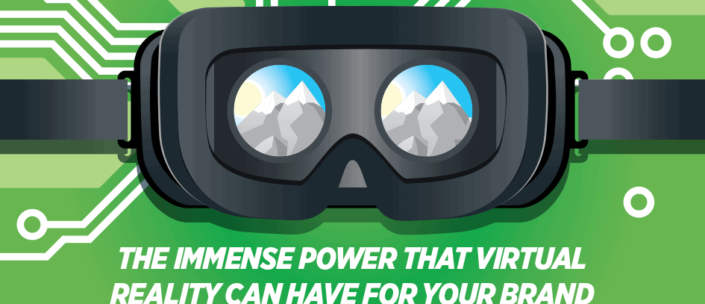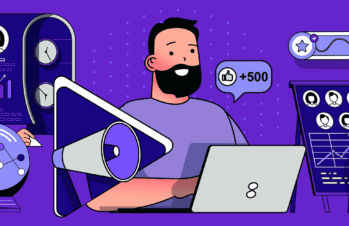If you’ve been paying attention, you know that virtual reality is being used for a whole lot more than scaring the pants off of gamers with apocalyptic zombie games.
Manufacturers are using VR and its cousin, augmented reality (AR), to help employees learn how to operate high-tech machinery.
Medical universities and hospitals are using VR for training and surgery simulations.
But perhaps more than any industry (after the gaming and entertainment industries, that is), it’s marketing that is embracing VR and AR with open arms. It didn’t take marketers long to discover that VR has incredible applications for brands, whether they’re selling shoes or pitching the next season of a popular TV show.
It’s easy to think “Hey, we should be using VR too!” when you’re brainstorming ideas for your next big marketing campaign. But how exactly do you employ VR effectively? How do you create something authentic, rather than gimmicky?
You’re not alone in asking that question. Lots of brands are struggling to figure out what VR can do for them, and how to use it organically to spread their message. And while the medium will certainly continue to evolve with time, here are a few pointers on how to make VR work for your brand now.
VR has a huge “wow factor,” but its real power is its massive storytelling potential.
When you think of experiences that lend themselves to virtual reality, there are always the obvious ones that pop up.
Roller coaster simulations.
Space travel.
Extreme sports, like skydiving.
These are all fun, exciting uses of virtual reality, but they’re essentially gimmicks. They’ve got plenty of use for video production companies that need to show off their VR skills, but they won’t do much for brands that are trying to market their products (unless you make roller coasters, spaceships, or parachutes, that is).
And while those experiences are bound to set your heart racing and give you a thrill, they probably won’t stick with you the way a VR story would.
A great example is Tom’s, the shoe company that gives one pair of shoes to a child in need for every pair that a customer buys. Tom’s created a beautiful, moving VR experience that takes viewers on a giving trip to a small village in Peru. Viewers get to see – and feel – what it’s like to hand out boxes of shoes to hundreds of joyful children.
The reason it works so well is that it’s on message, it’s authentic, and it’s a memorable story. There’s nothing gimmicky about seeing the positive impact that your dollars have on children around the world.
The Marriott hotel chain is doing something similar with its in-room VR offerings.
Marriott is a pioneer when it comes to VR, having created the 4D virtual reality travel experience, the Teleporter, back in 2014. When you step into the Teleporter and don your virtual reality headset, you’re transported to a luxury hotel, a serene beach in Maui, and the top of a London skyscraper. The Teleporter added in experiential elements like sprays of water and gentle breezes to really take the VR experience to another level.
While you can’t access the Teleporter in your Marriott hotel room, you can order a VR headset and headphones and experience one of the best things about travel: immersing yourself in the story of another place.
Marriott’s VR Postcards are immersive travel stories that take the viewer on a short journey with a real traveler to a unique location. You can visit an ice cream shop in Rwanda, the Chilean Andes Mountains, or the streets of Beijing.
While the Teleporter was incredibly popular, for obvious reasons, creating an entire 4D virtual reality machine is the kind of undertaking that only the largest companies with the biggest budgets can even consider. It’s heavy on the wow factor, but not as much on the emotional connection.
The VR Postcards, on the other hand, are simpler but more emotionally rich experiences. And since marketing today is all about creating authentic connections with customers, your brand would likely do better to create something simple and emotionally fulfilling, rather than mind-blowing but hollow.
If you sell a product, a VR demo can be a great way to build excitement.
Crafting beautiful VR stories is an important way to use VR, but there are some more practical uses for the technology, too.
If your business sells a product, creating a VR demo to show it off can be a highly effective way to build excitement around a launch.
For example, Volvo created a VR Test Drive experience for their XC90 SUV. Viewers find themselves right in the driver’s seat, driving through the countryside on a beautiful day.
This kind of product demo makes a lot of sense because test driving a car is a fairly big deal. You’re not going to head to a car dealership and ask to test drive something on a whim.
Being able to do so in VR expands Volvo’s reach to thousands of more customers, increasing not only their general brand audience, but also the possibility that someone who doesn’t live near a Volvo dealership will make the trip to test drive a Volvo in real life.
Another major advantage of VR for product-based businesses is that they can demo lots of products – not just one.
Consider a VR experience for a trade show or exhibition. When customers come to your booth, you can give them a VR headset that transports them into your showroom. Instead of the 5 or 10 square feet of your booth, they’re suddenly standing in a 1,000 square foot space, where they can check out multiple products instead of the one or two you were able to bring along.
While product demos can be quite practical and still be effective, you shouldn’t forget about the importance of storytelling when it comes to VR.
If all your customers want is a straightforward chance to see and “feel” your product, that’s fine – but if your product lends itself to a story, the way a luxury car or Tom’s shoes does, explore that avenue. You may end up with something far better than you could have imagined.
If you’re going to do VR, do VR well. If you’re not ready to make a full VR investment, consider 360 videos instead.
There’s no denying that VR is an expensive marketing tool. Full VR experiences can easily get into the tens of thousands of dollars, depending on how complex the project and how long the video is.
Since you don’t want to give your customers a mediocre VR experience, you should do plenty of research before committing to creating a VR video. Get bids from several agencies. If they’re coming in higher than you’re prepared to spend, consider a 360 video instead.
360 videos create similarly immersive experiences, but without the interactive component that VR offers. That lowers the cost substantially.
The New York Times, the Obama White House, and Conservation International have all created powerful 360 films – in fact, they can feel so immersive that the average viewer might not realize that they’re not technically VR.
VR and 360 video have immense powers for brands that are willing to jump in and make the investment. For more on how video can improve your marketing, read our post “Video and Social Media Marketing: Which Platform Will Boost Your Brand.”







